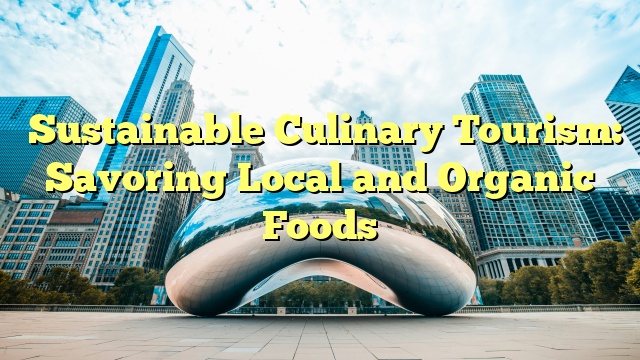Sustainable Culinary Tourism: Embracing Local and Organic Foods
The Rise of Culinary Tourism
Culinary tourism has rapidly gained popularity over the past decade, as travelers increasingly seek authentic cultural experiences through food. This trend underscores a desire to understand the world through its cuisines, exploring not just flavors, but also the stories, traditions, and histories behind them.
What is Culinary Tourism?
At its core, culinary tourism is about discovering a destination through its food. It’s not just about dining out, but about immersing oneself in all aspects of food culture. This includes visiting markets, attending food festivals, participating in cooking classes, and even engaging with local farmers or artisans. It’s a holistic experience that offers invaluable insights into a region’s identity.
Factors Driving Its Growth
Several elements have contributed to the boom in culinary tourism. The increased availability of travel information online, the proliferation of food-related media, and a growing global foodie culture have all played pivotal roles. These developments have enabled travelers not only to seek out exquisite dining experiences but to appreciate the origins and ethics of their food.
The Shift Towards Sustainability
With a heightened awareness of environmental issues, travelers are increasingly considering sustainability when choosing their culinary experiences. This shift is not merely about eating healthier but is part of a broader movement toward reducing the ecological footprint of travel.
Defining Sustainable Culinary Tourism
Sustainable culinary tourism focuses on minimizing the environmental impact of travel-related food activities. It encourages the consumption of local and organic products, supports regional economies, reduces food miles, and promotes biodiversity. By doing so, it seeks to preserve cultural heritage and natural resources for future generations.
Global Influence on Local Decisions
The effects of globalization on food systems have made many aware of the negative impacts of industrial agriculture, such as loss of biodiversity and excessive food miles. This consciousness has motivated a return to local, seasonal foods that are not only fresher but also less taxing on the environment.
Exploring the Benefits of Local and Organic Foods
Choosing local and organic foods offers an array of benefits, ranging from improved taste and health benefits to environmental and economic advantages.
Taste and Nutritional Quality
Local and organic foods are often fresher and more flavorful than their industrially produced counterparts, as they are harvested at peak ripeness. Additionally, organic farming methods prioritize soil health, which contributes to more nutrient-rich produce.
Environmental Impact
Opting for local foods reduces the demand for long-distance transportation, thereby decreasing greenhouse gas emissions and fossil fuel consumption. Organic farming practices further benefit the environment by avoiding synthetic pesticides and fertilizers, promoting soil fertility, and supporting biodiversity.
Economic and Community Impact
Purchasing local foods supports regional farmers and producers, helping to sustain local economies. This not only ensures the economic vitality of rural communities but also strengthens food security by fostering diverse and resilient food systems.
Experiencing Farm-to-Table Dining
Farm-to-table dining is a key aspect of sustainable culinary tourism, marrying gastronomy with environmental consciousness.
The Philosophy of Farm-to-Table
Farm-to-table dining emphasizes direct sourcing from local farms, ensuring that ingredients are seasonal, fresh, and sustainably produced. This approach not only enhances food quality but also establishes transparent and ethical relationships between producers and consumers.
Joining Local Farm Tours
Many travelers are now opting for farm tours, which provide a firsthand look at sustainable agriculture practices. These tours illuminate the journey of food from field to fork, allowing visitors to engage with the people and processes involved in creating their meals.
Restaurants Leading by Example
Globally, a growing number of restaurants are committed to the farm-to-table philosophy. These establishments often feature rotating menus that highlight seasonal specialties, paying homage to the best ingredients that local farms have to offer.
Engaging with Local Food Markets
For travelers seeking to immerse themselves in a region’s food culture, local markets are the ultimate destination.
The Vibrancy of Farmers Markets
Farmers markets are a celebration of local produce, providing fresh, seasonal goods directly from producers to consumers. They’re vibrant hubs where visitors can discover not just food, but authentic stories, fostering a deeper connection to the local culture.
Culinary Learning Opportunities
Markets offer numerous chances for culinary education. Many feature cooking demonstrations, workshops, and tastings. These activities deepen one’s understanding of food traditions and introduce travelers to new ingredients and cooking techniques.
Supporting Artisan Producers
Local markets often showcase a variety of artisan products, from cheeses and charcuterie to breads and pastries. By purchasing these goods, travelers not only enjoy high-quality products but also support the craft foods industry.
Joining Sustainable Food Festivals
Food festivals provide unique platforms for experiencing and promoting sustainable practices within the culinary tourism sector.
Celebrating Regional Specialties
Food festivals often highlight regional specialties, allowing visitors to savor distinct flavors and learn about traditional preparation methods. These events cultivate pride in local cuisines and provide visibility to regional farmers and producers.
Raising Awareness of Sustainability Issues
Many festivals incorporate sustainability-themed talks and workshops into their programming. These sessions address issues like food waste, sustainable sourcing, and ethical production, informing and inspiring attendees to make more conscious food choices.
Interactive and Educational Experiences
Hands-on activities at food festivals offer opportunities for learning and experimentation. Whether it’s mastering a traditional dish or participating in a farm-to-table demonstration, these experiences leave attendees with lasting skills and memories.
Challenges and Opportunities in Sustainable Culinary Tourism
As with any endeavor, sustainable culinary tourism faces challenges that can be turned into opportunities for growth and innovation.
Balancing Costs and Accessibility
While sustainable food is often more expensive due to higher production costs, finding ways to make it accessible to a broader audience is crucial. This could involve partnerships between governments, NGOs, and market players to subsidize costs and promote equitable access.
Promoting Transparency and Traceability
Building trust is essential in sustainable tourism. By using technology to increase transparency and traceability in food supply chains, businesses can reassure consumers about the authenticity and sustainability of their offerings.
Educating Travelers and Locals Alike
Educational initiatives are key to promoting sustainable practices. By informing both tourists and local residents about the benefits of sustainable food systems, it’s possible to foster a collective movement towards healthier and more environmentally friendly culinary habits.
The Future of Sustainable Culinary Tourism
The trajectory of sustainable culinary tourism seems promising as stakeholders increasingly commit to ecologically and culturally responsible practices.
Innovative Approaches to Sourcing
Technological advancements are enabling more efficient and sustainable methods of sourcing food. Innovations in agroecology, vertical farming, and aquaponics are just a few examples of how the industry is evolving towards more sustainable practices.
Collaborative Efforts Across Sectors
Stakeholders across sectors—governments, businesses, NGOs, and consumers—must collaborate to address the complex issues facing sustainable culinary tourism. By working together, it’s possible to create systemic change that benefits the environment, economies, and cultures involved.
Preserving Culinary Heritage
As sustainable culinary tourism grows, there is a renewed focus on preserving culinary heritage. Celebrating traditional cooking methods and indigenous ingredients helps maintain cultural diversity and enrich travelers’ experiences.
Practical Tips for Travelers
For those interested in practicing sustainable culinary tourism, several steps can ensure more responsible and meaningful travel experiences.
Research and Plan Ahead
Understanding the food landscape of a destination before you go can help you identify opportunities to engage in sustainable practices. Look for farm-to-table restaurants, markets, and events that prioritize local and organic foods.
Support Ethical Businesses
Choose to spend your money at businesses that are committed to sustainability. This could be a restaurant that sources locally, a market known for its organic produce, or a tour company focused on sustainable practices.
Engage with the Local Community
Interact with local farmers, chefs, and artisans to learn firsthand about their practices and challenges. This can provide valuable insights and deepen your appreciation of the local food culture.
Travel Light and Minimize Waste
Sustainable travel isn’t just about what you eat, but also how you travel. Reduce your carbon footprint by choosing eco-friendly transport options, minimizing food waste, and using reusable products whenever possible.
Share Your Experiences
Sharing your sustainable culinary tourism experiences can inspire others to consider the impact of their food choices when traveling. Social media, blogs, and travel reviews are wonderful platforms for showcasing the benefits of sustainable travel.
By embedding sustainability into the very fabric of culinary tourism, travelers can play a part in forging a future where food is celebrated in ways that honor the planet and its diverse cultures.






























